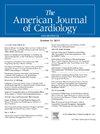Echocardiographic Assessment of Cardiac Remodeling According to Obesity Class
IF 2.3
3区 医学
Q2 CARDIAC & CARDIOVASCULAR SYSTEMS
引用次数: 0
Abstract
Evidence supports the existence of cardiac remodeling in obesity; however, no standard diagnostic criteria has been proposed or validated. This study aimed to identify echocardiographic features of cardiac remodeling according to obesity class and assess the effect of nonsurgical weight loss on cardiac structure and function. A total of 120 patients were divided according to their obesity class (group 1: body mass index [BMI] 18.5 to 24.9, group 2: 25 to 29.9, group 3: 30 to 39.9, and group 4: >40) and underwent cross-sectional transthoracic echocardiography. Echocardiographic parameters of cardiac chamber quantification and function were compared among the 4 groups. Echocardiographic parameters were compared before and after nonsurgical weight loss in a subgroup of patients. Overall, there was an incremental increase in left ventricular (LV), left atrial (LA), and right ventricular dimensions, LV mass (LVM), and LV stroke volume (all p <0.0001) across the obesity classes. There was no significant difference in LV ejection fraction or right ventricular systolic function, as assessed by tricuspid annular plane systolic excursion; however, there was a significant decrease in global longitudinal strain (BMI 18.5 to 24.9: 22.8 ± 1.7%, BMI 25 to 29.9: 22.0 ± 1.4%, BMI 30 to 39.9: 20.8 ± 1.1%, BMI >40: 20.6 ± 1.3%, p <0.0001) and LA strain (BMI 18.5 to 24.9: 37.7 ± 2.3%, BMI 25 to 29.9: 32.8 ± 2.1%, BMI 30 to 39.9: 31.5 ± 1.8%, BMI >40: 29.0 ± 2.8%, p <0.0001). Allometric height-indexed LV and LA dimensions increased with increasing BMI class (p <0.0001). Echocardiographic parameters did not change significantly after nonsurgical weight loss. In conclusion, echocardiographic features can be described according to obesity class. Allometric height indexation may better reflect cardiac remodeling in obesity than body surface area indexation. Nonsurgical weight loss was not associated with significant changes in cardiac chamber dimensions and function.
根据肥胖程度对心脏重塑进行超声心动图评估
本研究旨在根据肥胖等级确定心脏重塑的超声心动图特征,并评估非手术减重对心脏结构和功能的影响。共有 120 名患者根据肥胖等级(第 1 组:BMI 18.5-24.9;第 2 组:25-29.9;第 3 组:30-39.9;第 4 组:>40)进行了横断面经胸超声心动图检查。对 4 组患者的心腔定量和功能的超声心动图参数进行比较。在一个患者分组中,比较了非手术减重前后的超声心动图参数。总体而言,左心室(LV)、左心房(LA)和右心室的尺寸、左心室质量和左心室搏出量均有增加(全部 p40:20.6%±1.3%,p40:29.0%±2.8%,p40:20.6%±1.3%,p40:29.0%±2.8%)。
本文章由计算机程序翻译,如有差异,请以英文原文为准。
求助全文
约1分钟内获得全文
求助全文
来源期刊

American Journal of Cardiology
医学-心血管系统
CiteScore
4.00
自引率
3.60%
发文量
698
审稿时长
33 days
期刊介绍:
Published 24 times a year, The American Journal of Cardiology® is an independent journal designed for cardiovascular disease specialists and internists with a subspecialty in cardiology throughout the world. AJC is an independent, scientific, peer-reviewed journal of original articles that focus on the practical, clinical approach to the diagnosis and treatment of cardiovascular disease. AJC has one of the fastest acceptance to publication times in Cardiology. Features report on systemic hypertension, methodology, drugs, pacing, arrhythmia, preventive cardiology, congestive heart failure, valvular heart disease, congenital heart disease, and cardiomyopathy. Also included are editorials, readers'' comments, and symposia.
 求助内容:
求助内容: 应助结果提醒方式:
应助结果提醒方式:


